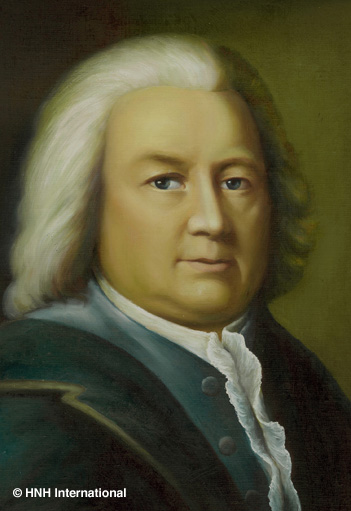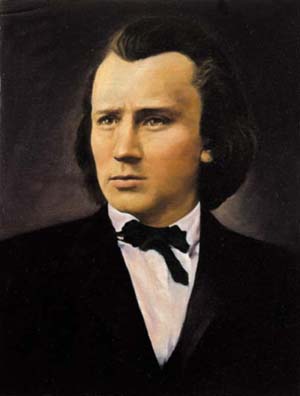
Johann Sebastian Bach belonged to a dynasty of musicians. In following inevitable family tradition, he excelled his forebears and contemporaries, although he did not always receive in his own lifetime the respect he deserved. He spent his earlier career principally as an organist, latterly at the court of one of the two ruling Grand Dukes of Weimar. In 1717 he moved to Cöthen as Court Kapellmeister to the young Prince Leopold and in 1723 made his final move to Leipzig, where he was employed as Cantor at the Choir School of St Thomas, with responsibility for music in the five principal city churches. In Leipzig he also eventually took charge of the University Collegium musicum and occupied himself with the collection and publication of many of his earlier compositions. Despite widespread neglect for almost a century after his death, Bach is now regarded as one of the greatest of all composers. Bach-Werke-Verzeichnis numbers, abbreviated to BWV, are generally accepted for convenience of reference.
Choral and Vocal Music
Bach wrote a very large amount of choral music, particularly in connection with his employment at Leipzig. Here, he prepared complete cycles of cantatas for use throughout the church year, in addition to the larger-scale settings of the Latin Mass and the accounts of the Passion from the gospels of St Matthew and of St John. These works include the Mass in B minor, BWV 232, St Matthew Passion, BWV 244, St John Passion, BWV 245, Christmas Oratorio, BWV 248, Easter Oratorio, BWV 249, and the revised setting of the Magnificat, BWV 243. Cantatas include, out of over 200 that survive, Herz und Mund und Tat und Leben, BWV 147 (from which the pianist Dame Myra Hess took her piano arrangement under the title Jesu, Joy of Man’s Desiring, making this the most popular of all), Ein feste Burg ist unser Gott, BWV 80, Ich habe genug, BWV 82, Jesu, meine Freude, BWV 358, Mein Herze schwimmt im Blut, BWV 199, Wachet auf, BWV 140, and Jauchzet Gott in allen Landen, BWV 51, for soprano, trumpet, strings and basso continuo. The rather more formal half dozen or so motets include a memorable version of Psalm CXVII, Lobet den Herrn, alle Heiden, BWV 230.
Secular cantatas include the light-hearted Coffee Cantata, BWV 211 (a father’s attempt to stem his daughter’s addiction to the fashionable drink), the Peasant Cantata, BWV 212 (in honour of a newly appointed official), and two wedding cantatas, Weichet nur, BWV 202, and O holder Tag, BWV 210. Was mir behagt, ist nur die muntre Jagd, BWV 208, was written in 1713 to celebrate the birthday of the hunting Duke Christian of Saxe-Weissenfels and later reworked for the name day of August III, King of Saxony, in the 1740s. The Italian Non sa che sia dolore, BWV 209, apparently marked the departure of a scholar or friend from Leipzig.
Organ Music
Much of Bach’s organ music was written during the earlier part of his career, culminating in the period he spent as court organist at Weimar. Among many well-known compositions we may single out the Chromatic Fantasia and Fugue in D minor, BWV 903, the Dorian Toccata and Fugue in D minor, BWV 538, the Toccata, Adagio and Fugue, BWV 564, Fantasia and Fugue in G minor, BWV 542, Passacaglia and Fugue in C minor, BWV 582, Prelude and Fugue “St Anne”, BWV 552 (in which the fugue theme resembles the well-known English hymn of that name), Toccata and Fugue in D minor, BWV 565, and the Toccata and Fugue in F, BWV 540.
Chorale preludes are compositions for organ that consist of short variations on simple hymn tunes for all seasons of the church year. Better-known melodies used include the Christmas In dulci jubilo, BWV 608, Puer natus in Bethlehem, BWV 603, the Holy Week Christ lag in Todesbanden, BWV 625, and the Easter Christ ist erstanden, BWV 627, as well as the moving Durch Adam’s Fall ist ganz verderbt, BWV 637, and the familiar Wachet auf, ruft uns die Stimme, BWV 645, and Nun danket alle Gott, BWV 657.
Other Keyboard Music
Important sets of pieces are the six English Suites, BWV 806–11, the six French Suites, BWV 812–17, the ‘Goldberg’ Variations, BWV 988 (written to soothe an insomniac patron), the ‘Italian’ Concerto, BWV 971, the six partitas, BWV 825–30, and the monumental two books of preludes and fugues in all keys, The Well-Tempered Clavier, BWV 846–93—the so-called ‘48’.
Chamber Music
During the period Bach spent at Cöthen he was able to devote his attention more particularly to instrumental composition for solo instruments, for smaller groups or for the small court orchestra.
Particularly important are the three sonatas and three partitas for unaccompanied violin, BWV 1001–6, works that make great technical demands on a player, and the six suites for unaccompanied cello, BWV 1007–12. There are six sonatas for violin and harpsichord, BWV 1014–19, and an interesting group of three sonatas for viola da gamba and harpsichord, sometimes appropriated today by viola players or cellists, BWV 1027–9. The Musical Offering resulted from Bach’s visit in 1747 to the court of Frederick the Great, where his son Carl Philipp Emanuel was employed. From a theme provided by the flautist king he wrote a work that demonstrates his own contrapuntal mastery and includes a trio sonata for flute, violin and continuo. Bach had earlier in his career written a series of flute sonatas, as well as a partita for unaccompanied flute.
Orchestral Music
The six ‘Brandenburg’ Concertos, BWV 1046–51, dedicated to the Margrave of Brandenburg in 1721, feature a variety of forms and groups of instruments, while the four orchestral suites or overtures, BWV 1066–1069, include the famous ‘Air on the G String’, a late-19th-century transcription of the Air from the Suite in D major, BWV 1068.
Concertos
Three of Bach’s violin concertos, written at Cöthen between 1717 and 1723, survive in their original form, with others existing now only in later harpsichord transcriptions. The works in original form are the Concertos in A minor and in E major, BWV 1041 and 1042, and the Double Concerto in D minor for two violins, BWV 1043.
Bach wrote or arranged his harpsichord concertos principally for the use of himself and his sons with the Leipzig University Collegium musicum between 1735 and 1740. These works include eight for a single solo harpsichord and strings, BWV 1052–9, and others for two, three and four harpsichords and strings. It has been possible to provide conjectural reconstructions of lost instrumental concertos from these harpsichord concertos, including a group originally for oboe and the oboe d’amore and one for violin and oboe.

Born in Hamburg, the son of a double bass player and his older seamstress wife, Brahms attracted the attention of Schumann, to whom he was introduced by the violinist Joachim. After Schumann’s death he maintained a long friendship with the latter’s widow, the pianist Clara Schumann, whose advice he always valued. Brahms eventually settled in Vienna, where to some he seemed the awaited successor to Beethoven. His blend of Classicism in form with a Romantic harmonic idiom made him the champion of those opposed to the musical innovations of Wagner and Liszt. In Vienna he came to occupy a position similar to that once held by Beethoven, his gruff idiosyncrasies tolerated by those who valued his genius.
Orchestral Music
Brahms wrote four symphonies, massive in structure, and all the result of long periods of work and revision. The two early serenades have their own particular charm, while Variations on a Theme by Haydn—in fact the St Anthony Chorale, used by that composer—enjoys enormous popularity, as it illustrates a form of which Brahms had complete mastery. A pair of overtures—the Academic Festival Overture and the Tragic Overture—and arrangements of his Hungarian Dances complete the body of orchestral music without a solo instrument. His concertos consist of two magnificent and demanding piano concertos, a violin concerto and a splendid double concerto for violin and cello.
Chamber Music
Brahms completed some two dozen pieces of chamber music, and almost all of these have some claim on our attention. For violin and piano there are three sonatas, Opp 78, 100 and 108, with a separate Scherzo movement for a collaborative sonata he wrote with Schumann and Dietrich for their friend Joachim. For cello and piano he wrote two fine sonatas: Opp 38 and 99. There are two late sonatas, written in 1894, for clarinet/viola and piano, Op 120, each version deserving attention, as well as the Clarinet Trio, Op 114, for clarinet, cello and piano, and the Clarinet Quintet, Op 115, for clarinet and string quartet, both written three years earlier. In addition to this, mention must be made of the three piano trios, Opp 8, 87 and 101; the Horn Trio, Op 40 for violin, horn and piano; three piano quartets, Opp 25, 26 and 60; the Piano Quintet, Op 34; and three string quartets, Opp 51 and 67. Two string sextets, Opp 18 and 36, and two string quintets, Opp 88 and 111, complete the list.
Piano Music
If all the chamber music of Brahms should be heard, the same may be said of his music for piano. Brahms showed a particular talent for the composition of variations, and this is aptly demonstrated in the famous Variations on a Theme by Handel, Op 24, with which he made his name at first in Vienna, and the ‘Paganini’ Variations, Op 35, based on the theme of the great violinist’s Caprice No. 24. Other sets of variations show similar skill, if not the depth and variety of these major examples of the art. Four Ballades, Op 10, include one based on a real Scottish ballad, Edward, a story of parricide. The three piano sonatas, Opp 1, 2 and 5, relatively early works, are less well known than the later piano pieces, Opp 118 and 119, written in 1892, and the Fantasias, Op 116, of the same year. Music for four hands, either as duets or for two pianos, includes the famous Hungarian Dances (often heard in orchestral and instrumental arrangement) and a variety of original compositions and arrangements of music better known in orchestral form.
Vocal and Choral Music
There is again great difficulty of choice when we approach the large number of songs written by Brahms, which were important additions to the repertoire of German Lied (art song). The Liebeslieder Waltzes, Op 52, for vocal quartet and piano duet are particularly delightful, while the solo songs include the moving Four Serious Songs, Op 121, reflecting preoccupations as his life drew to a close. ‘Wiegenlied’ (‘Cradle Song’) is one of a group of five songs, Op 49; the charming ‘Vergebliches Ständchen’ (‘Vain Serenade’) appears in the later set Five Romances and Songs, Op 84, and there are two particularly wonderful songs for contralto, viola and piano, Op 91: ‘Gestillte Sehnsucht’ (‘Tranquil Yearning’) and the Christmas ‘Geistliches Wiegenlied’ (‘Spiritual Cradle-Song’), Op 91, based on the carol ‘Josef, lieber Josef mein’(‘Joseph dearest, Joseph mine’).
Major choral works by Brahms include the monumental A German Requiem, Op 45, a setting of biblical texts; the Alto Rhapsody, Op 53, with a text derived from Goethe; the Schicksalslied (‘Song of Destiny’), Op 54 (a setting of Hölderlin); and a series of accompanied and unaccompanied choral works, written for the choral groups with which he was concerned in Hamburg and in Vienna.






























